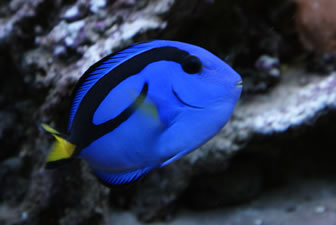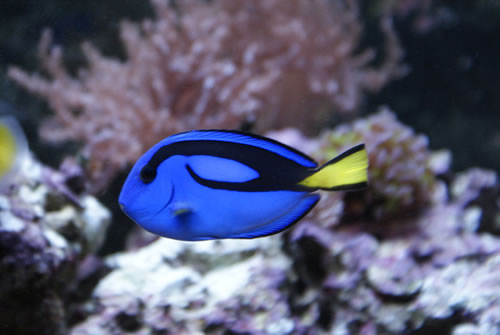Blue Hippo Tang
Paracanthurus hepatus
Paracanthurus hepatus is known under many different common names in English, such as Blue hippo tang, Hippo tang, Blue tang, Pacific blue tang, Regal tang, Wedge-tailed tang, Wedgetail blue tang, Hepatus tang, Palette surgeonfish, Palette surgeon, Blue surgeon, Blue surgeonfish, and Flagtail surgeonfish.
The common name Blue tang is used for several other species as well, such as Acanthurus coeruleus.
Paracanthurus hepatus has not been evaluated for the IUCN Red List of Threatened Species.
Geographical range, habitat and habits
The Blue hippo tang lives in the Indo-Pacific. Its geographical range stretches from East Africa (including the Mascarene Islands) to Kiribati, and northwards up to southern Japan. Southwards, the range proceeds down to the southern Great Barrier Reef, New Caledonia, and Samoa. The geographical limits of this species are 30°N to 30°S, and 32°e to 170°w.
The Blue hippo tang inhabits clear, current-swept terraces of seaward reefs. This is a rather uncommon and highly localized fish species with a depth range of 2-40 meters / 6-130 feet. It is an engybenthic species that has been observed on loose aggregations 1-2 meters /3-6 feet over the bottom. Juveniles and subadults are known to live in groups and hang out near isolated coral heads of the species Pocillopora eydouxi. When frightened, they will hide among coral branches. The Blue hippo tang is active during the day and rests during the night.
Size and appearance
The largest scientifically measured Blue hippo tang was 31.0 cm /12.2 in.
As the common name suggests, the Blue hippo tang is chiefly bright blue in colour, but it is adorned with black markings and has a yellow caudal fin. The caudal fin sports a black stripe along both the upper and lower margins. The colour of this fish can change rapidly depending on mood.
A razor-sharp spine (the “scalpel” is found on both sides of the caudal peduncle and the fin spines are venomous. (The fish is equipped with an anterolateral glandular groove with a venom gland.)
Blue hippo tang care
The aquarium where you house your Blue hippo tang must include suitable hiding spots as well as plenty of open water for swimming. It is not advisable to use an aquarium smaller than 75 gallons / 285 litres.
As mention above, the Blue hippo tang inhabits clear, current-swept terraces of seaward reefs and will appreciate similar conditions in the aquarium. Turbulent water movements are recommended and it is imperative to keep the oxygen level up. The water quality must be high and the water clear.
The Blue hippo tang can be kept together with members of its own species as well as with other peaceful species that won’t harass it. It is considered one of the least territorial species of its family. It may shake its caudal spine to scare of fish, but actual attacks are very rare. If you want to keep more than one Blue hippo tang, introduce the simultaneously. If you have to add a new specimen later, ideally pick one that is bigger than the ones that already inhabit the aquarium.
The Blue hippo tang is considered reef safe.
Don’t worry if you find your Blue hippo tang lying on its side on the substrate; it is only natural and doesn’t mean that the fish is dead or trying to remove skin parasites. Excessive scratching is on the other hand a sign of parasitic skin problems. This species is rather susceptible to skin disease, such as marine ich and marine velvet.
The recommended water temperature when keeping Blue hippo tang is 22-26° C / 72-79° F. Keep the pH-value in the 8.1-8.4 range and the specific gravity from 1.020 to 1.025.
Feeding Blue hippo tang
In the wild, the Blue hippo tang feeds chiefly on benthic and planktivorous invertebrates and attached algae.
In the aquarium, it should be kept on a varied omnivore diet to ensure optimal health. This is a curious creature that will give most type of food a try and is therefore easy to train onto new food types. You can for instance give your fish meaty foods such as shrimps plus fresh algae and algae-based foods. Boiled vegetables, e.g. zucchini and broccoli, are appreciated by some individuals. Adding a high-quality flake food rich in vitamin C to the diet is a good idea, because vitamin deficiency is believed to increase the risk of head and lateral line erosion.
If kept with bullying tank mates, the Blue hippo tang may stop eating or eat too little.
Breeding Blue hippo tang
The Blue hippo tang is an egg scattering species. We do not have any information about breeding Blue hippo tang in aquariums.
Surgeonfish - Tang Articles:
Achilles Surgeonfish – Acanthurus achilles
Atlantic Blue Tang – Acanthurus coeruleus
Chevron Tang – Ctenochaetus hawaiiensis
Clown Surgeonfish – Acanthurus lineatus
Convict Surgeonfish – Acanthurus triostegus
Desjardinii Tang – Zebrasoma desjardinii
Kole Tang – Ctenochaetus strigosus
Mimic Surgeonfish – Acanthurus pyroferus
Naso Tang – Naso lituratus
Orangeshoulder Surgeonfish – Acanthurus olivaceus
Powder Blue Tang – Acanthurus leucosternon
Powder Brown Tang – Acanthurus japonica
Purple Tang – Zebrasoma xanthurum
Sailfin Tang – Zebrasoma veliferum
Scopas Tang – Zebrasoma scopas
Whitecheek Surgeonfish – Acanthurus nigricans
Yellow Tang – Zebrasoma flavescens


